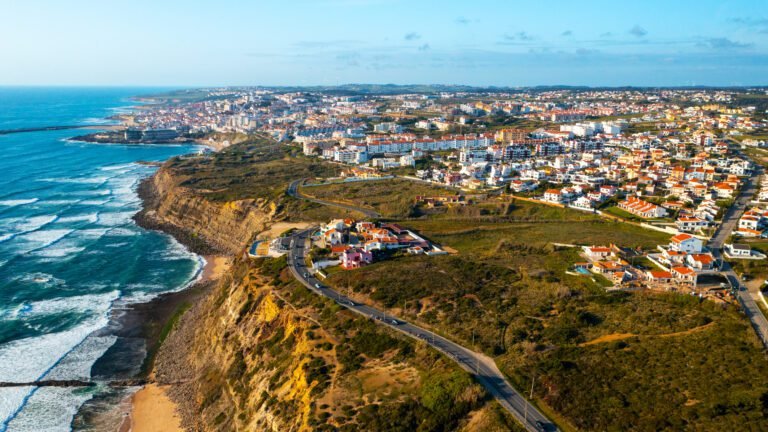In Lisbon’s Príncipe Real neighborhood, I watched azulejo artisans carefully restore a 1920s Art Deco building. Each hand-painted ceramic tile – some original, some newly commissioned – told a story spanning a century. The building’s owner, a Barcelona architect, explained: “I didn’t buy an investment property. I bought participation in Portugal’s architectural dialogue.”
This sentiment captures something profound happening in Portuguese real estate. While Paris commands €15,000/m² and London hovers around €12,000/m², Lisbon offers comparable architectural heritage at €5,000-7,000/m² (data source). But the appeal transcends price. Portugal presents a rare phenomenon: a European capital experiencing an architectural renaissance while remaining financially accessible.
The Architectural Awakening
Portugal’s design identity was always present – azulejo traditions date to the 15th century, Manueline Gothic showcases maritime exploration heritage, and Portuguese modernists Álvaro Siza and Eduardo Souto de Moura won Pritzker Prizes. But international recognition lagged until recently.
The 2010s financial crisis devastated Portugal’s economy, leaving architectural gems neglected. Historic buildings across Lisbon, Porto, and beyond fell into disrepair. Then, beginning around 2015, something shifted. The Lisbon Architecture Triennale gained international prominence. Design hotels transformed abandoned palaces. Creative professionals discovered Portuguese cities offered what Brooklyn and Berlin provided a decade earlier: rich cultural infrastructure meeting affordable entry points.
By 2024, Lisbon property values had increased 120% since 2015. Notably, historic buildings with preserved original features outperformed the general market by 40%. The data reveals what architects already knew: authentic architectural character commands premium value.
Understanding Portuguese Architectural DNA
Portuguese architecture succeeds through synthesis rather than dominance of single styles.
The Azulejo Tradition forms Portugal’s most recognizable design element. These hand-painted ceramic tiles aren’t mere decoration – they’re architectural storytelling. Walk through Alfama and encounter 18th-century blue-and-white geometric patterns. In Principe Real, discover Art Nouveau floral motifs from 1905. The tradition never disappeared; contemporary Portuguese architects incorporate azulejo work into modern projects, creating temporal conversations on building façades.
What makes this significant for investors?
Original azulejo panels increase property values measurably. A 2023 study by Lisbon’s Municipal Architecture Department found properties with authenticated azulejo work commanded 15-25% premiums over comparable properties without such features. More importantly, these elements can’t be replicated inexpensively – hand-painting traditional azulejo tiles requires artisan skills passed through generations.
- Pombaline Architecture emerged after the catastrophic 1755 Lisbon earthquake. Marquês de Pombal rebuilt downtown Lisbon using earthquake-resistant construction and rational urban planning – Europe’s first grid system. These buildings feature remarkable consistency: elegant proportions, limestone façades, wrought-iron balconies, and human-scaled streets.
Today, Pombaline buildings represent some of Lisbon’s most coveted real estate. The Baixa district’s grid – once criticized as monotonous – now attracts architects appreciating its urbanist vision. Purchase prices range from €4,500-6,500/m², with renovation potential adding significant value.
- Portuguese Modernism deserves special attention. While international modernism often felt austere, Portuguese modernists like Siza and Souto de Moura created work that honored context. Their buildings dialogue with surroundings rather than dominating them. Clean lines meet tactile materials. Geometric precision accommodates human scale.
This Portuguese modernist approach influences contemporary architecture across the country. Visit Porto’s Serralves Museum or Lisbon’s Champalimaud Centre – you’ll see architecture that’s unquestionably modern yet distinctly Portuguese.
Investment-Grade Design Districts
Lisbon: Príncipe Real & Santos
These adjacent neighborhoods represent Lisbon’s design-conscious evolution. Príncipe Real offers late 19th and early 20th-century buildings – Belle Époque and Art Deco predominantly. You’ll find apartment buildings featuring original hydraulic tile floors (geometric cement tiles popular 1890-1930), ornate plasterwork, and 4-meter ceiling heights impossible in modern construction.
Investment profile: €5,000-7,000/m² purchase prices, with 4-6% rental yields for well-renovated properties. The neighborhood attracts creative professionals, design boutiques, and artisan workshops – creating cultural ecosystem that sustains property values.
Santos, immediately southwest, offers similar architectural character at slightly lower prices (€4,500-6,000/m²). The neighborhood feels more residential, with families and long-term residents balancing the creative newcomers.
Both neighborhoods share crucial characteristic: design community presence. When architects, designers, and craftspeople cluster in neighborhoods, they drive appreciation through both renovation quality and cultural programming.
Lisbon: Alfama & Mouraria
For investors seeking deeper historical character, these medieval neighborhoods provide extraordinary opportunities. Alfama survived the 1755 earthquake, preserving Lisbon’s oldest urban fabric. Narrow streets wind between whitewashed buildings, Moorish-influenced architecture remains visible, and neighborhood life continues largely as it has for centuries.
Investment appeal here differs from Príncipe Real. Properties cost less (€3,200-5,000/m²), but renovation complexity increases. Buildings may be 300-500 years old, requiring specialist contractors understanding traditional construction methods. Heritage protection rules limit façade alterations.
Yet for design-conscious investors, these constraints create value. Properties in Alfama can’t be easily replicated or mass-produced. The neighborhood’s authenticity – fado houses, neighborhood associations, local festivals – sustains cultural tourism that drives rental demand.
Mouraria, Alfama’s neighbor, offers similar character with greater affordability (€2,800-4,500/m²). The neighborhood has historically been overlooked but now attracts artists, musicians, and design professionals seeking authentic Lisbon life.
Porto: Cedofeita & Miguel Bombarda
Porto’s design credentials rival Lisbon’s but receive less international attention – creating opportunity. The Cedofeita and Miguel Bombarda districts transformed from industrial zones into Porto’s creative heart. Former textile warehouses became design studios, galleries, and residential lofts.
Architecture here blends 19th-century industrial bones (exposed brick, timber beams, high ceilings) with contemporary interventions. Siza’s Museum of Contemporary Art anchors the neighborhood, establishing design credibility.
Investment profile: €2,800-4,500/m² – significantly below Lisbon despite comparable architectural quality and cultural vibrancy. Porto’s smaller international profile means discerning investors find better value.
The Ribeira district, Porto’s UNESCO-protected riverfront, offers different appeal. Colorful 18th-century merchant houses cascade toward the Douro River, many featuring azulejo façades. Prices range €4,000-6,500/m² for premium river-view properties.
Alentejo: Contemporary Rural Architecture
Beyond cities, Portugal’s Alentejo region south of Lisbon demonstrates how contemporary architecture integrates with traditional landscapes. Comporta and Melides – formerly fishing villages – now attract international architects designing minimalist coastal retreats.
These aren’t historic restorations; they’re contemporary architecture in dialogue with landscape. White stucco volumes sit among cork oak forests. Floor-to-ceiling glass frames Atlantic views. Natural materials – cork, timber, local stone – ground buildings in Portuguese context.
Investment profile differs: land + construction costs €3,000-5,000/m² total, creating 200-300m² villas for €600,000-1.5 million. Rental yields run 3-5%, but capital appreciation potential interests investors recognizing Comporta as Portugal’s emerging Hamptons equivalent.
Madeira: Island Architecture Meets Atlantic Drama
Madeira represents a completely different architectural conversation within Portugal’s design landscape. The island’s volcanic topography creates architectural challenges that have produced remarkable solutions – levada-integrated properties where historic irrigation channels become design features, terraced villas cantilevered over dramatic cliff faces, and quinta estates where traditional Madeiran stone construction meets contemporary glass pavilions.
“We’re seeing investors with their architects from Scandinavia and Northern Europe particularly drawn to properties where Atlantic light, year-round subtropical climate, and dramatic topography create opportunities for architectural experimentation within a culturally rich context. Investment values start around €3,500/m² for renovation projects in Funchal’s historic center, rising to €6,000-8,000/m² for contemporary villas with ocean views,” says Filipe Pereira from the travel blog TrueMadeira.
The Craftsmanship Advantage
Portugal’s architectural investment appeal extends beyond buildings themselves to the artisan ecosystem surrounding them.
Unlike many European countries where traditional building crafts disappeared with industrialization, Portugal retained working artisans across multiple disciplines. Azulejo tile workshops still hand-paint ceramics using 500-year-old techniques. Lime plastering specialists understand traditional wall finishes. Stone masons work local limestone using methods unchanged for generations.
For property investors, this creates tangible advantage. Authentic restoration becomes possible – and affordable. A Toronto-based architect I interviewed purchased a Lisbon townhouse requiring comprehensive restoration. Working with local azulejo artisans, she restored original 1880s tile panels for €18,000 – investment that increased property value by €122,000 according to post-renovation appraisal.
Compare this to attempting period restoration in London or New York, where finding qualified craftspeople costs premium rates and authentic materials require expensive sourcing. Portugal’s living craft traditions make quality restoration accessible.
This craftsmanship economy extends beyond individual projects. Neighborhoods with active artisan communities – workshops, studios, craft cooperatives – develop cultural character that sustains property values. Príncipe Real’s concentration of artisan shops, design boutiques, and craft studios creates neighborhood identity that attracts both residents and tourists.
Navigating Portugal’s Design-Led Property Market
Approaching Portuguese property investment through design lens requires different expertise than conventional real estate transactions.
Working with architectural specialists matters. Standard real estate agents understand square meters and price comparisons. Design-focused specialists understand period features, restoration potential, heritage restrictions, and artisan networks. According to a 2024 Portugal Buyers Agent analysis, properties purchased with architectural guidance appreciated 30-40% faster than comparable generic purchases.
Understanding heritage regulations prevents costly mistakes. Many Portuguese buildings carry heritage protections limiting alterations. These restrictions protect architectural character but complicate renovations. Façade modifications may require municipal approval. Interior alterations affecting structural elements need permits. Knowledgeable guidance navigates these requirements while identifying renovation opportunities within regulations.
Budgeting for quality restoration matters. Historic Portuguese properties typically require €800-1,500/m² for comprehensive renovation maintaining original character. This exceeds basic renovation costs but protects architectural value. Cutting corners – covering original tiles, painting over plasterwork, installing generic fixtures – destroys the character justifying investment in the first place.
Timeline expectations need adjustment. Historic building renovation in Portugal takes longer than modern construction. Specialist contractors work carefully, heritage approvals add time, and discovering hidden original features (common in Portuguese buildings) necessitates design adjustments. Budget 6-18 months for quality historic renovation versus 3-6 months for modern property updates.
The Cultural Investment Proposition
Portuguese architectural investment transcends financial returns alone.
You’re participating in cultural preservation. When you restore azulejo panels or maintain original plasterwork, you protect Portuguese heritage. These buildings survived centuries; your stewardship ensures they survive future centuries.
You’re supporting craft traditions. Hiring azulejo artisans, stone masons, and traditional plasters sustains these professions for next generations. Your renovation budget becomes cultural investment.
You’re joining creative communities. Portugal’s design scene – architects, artists, designers, craftspeople – creates vibrant cultural ecosystem. Owning property in design-conscious neighborhoods means participating in this community rather than merely observing it.
The aesthetic dividends compound daily. Living surrounded by architectural beauty, craftsmanship, and design attention shapes experience in ways standard property investment never captures.
The Long-Term Design Thesis
Portugal’s architectural emergence mirrors Brooklyn’s 2000s transformation and Berlin’s 2010s evolution. Creative professionals discover cities offering cultural richness and affordable entry points. Design communities form. Property values appreciate.
Portugal remains earlier in this trajectory than Brooklyn or Berlin – creating opportunity for investors recognizing the pattern. Current pricing still reflects Portugal’s recent financial struggles rather than its design potential.
Consider the metrics: Lisbon averages €5,500/m² compared to Paris’s €15,000/m² or London’s €12,000/m². Yet architectural heritage compares favorably. UNESCO recognizes Lisbon’s Belém, Porto’s center, and several other Portuguese sites. Pritzker Prize-winning architects work actively across Portugal. International design attention grows yearly.
The convergence of authentic architectural heritage, living craft traditions, vibrant design communities, and accessible pricing creates investment opportunity rare in Western Europe.
For design-conscious investors who value architecture as lived experience rather than mere asset class, Portugal offers compelling proposition. You’re not simply buying property – you’re acquiring participation in one of Europe’s most authentic design cultures at entry point unlikely to persist indefinitely.
The question isn’t whether Portugal’s architectural renaissance will continue. The cultural momentum is clear. The question is whether you’ll recognize the moment before it becomes obvious to everyone else.


































